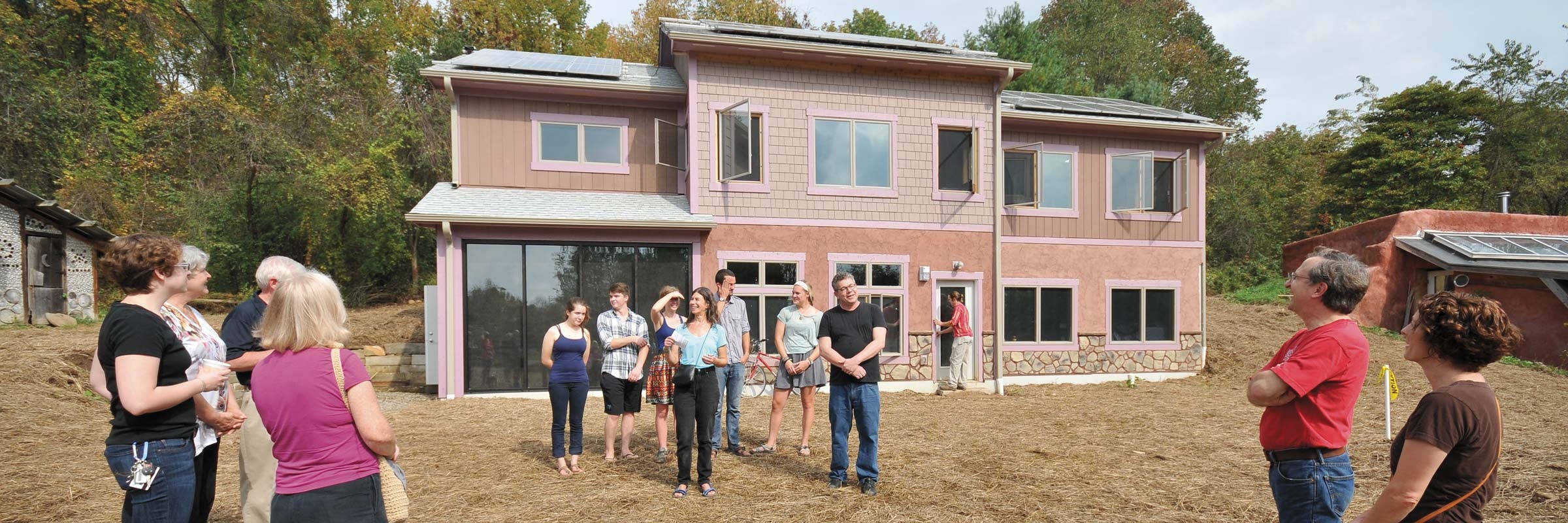If residents of the Homestead wanted to plug anything in last year, they had to rely on only a few outlets in the community center, known as “Cabin Bob,” where energy is needed to keep the refrigerator running. The minimal electricity edict was a purposeful decision back in the ’70s when the Homestead was built as an experiment in sustainable living, but times, they are a-changin’.
“Doing work on a computer is an unavoidable necessity as a student these days,” says Ryan Culligan ’14, a current Homie. So when the Homestead residents built their new cabin this summer, they chose to include some power outlets, but it was not a decision they made lightly. They worried, for example, about the possible effects of enabling more technology use. What if someone decided to plug in a toaster oven? Or a halogen lamp? Or a television? They were wary, not just of environmental impact, but also of the potential consequences for the sense of community they’ve worked so hard to develop.
So far, though, the change has been a welcome one. Since residents know they can do work on a computer at the Homestead, they return home earlier in the evening and actually end up spending more time with one another. “People are spending the whole night in the new cabin and working together,” Culligan says. “It’s really helped the community out in a lot of ways that aren’t readily apparent.”
This is a community that began building its own house together last March, and more or less finished by mid-August. “No one had true construction experience before,” Culligan says with a laugh. “We had a lot of things that we had to improvise—but not as many as we have had in the past, because we actually had people helping us out.” People like local contractor and former Homestead resident Richard Downs ’77, as well as architects and others who could provide expert advice to a group used to employing creative approaches to a broad range of problems. Once they have drawn up plans, they worked with architects, who reinterpreted their proposals to make sure everything was in line with building and safety codes. (Previous Homestead cabins were designated “experimental” buildings, but the newest addition required an official building permit. “Everything out here is held up to the same standard as anything on Denison’s campus,” says Culligan.)
Walking through the spacious new cabin, which sleeps nine, Culligan says, “It’s crazy how much the place has changed in the past year and a half.” And it’s not just more power to fire up computers and charge cell phones. For the first time in the Homestead’s 36-year history, residents have access to such luxuries as a shower and an indoor bathroom. “We wanted to maintain the community feel and the open space, but at the same time we needed to modernize,” explains Culligan.
The amenities may have changed, but the mission and values have not; great care was taken to ensure that the new accommodations are as sustainable as possible. Over the summer, students built a system that converts waste from the new toilet into compost. In consultation with Bob Jude, Denison’s heating and cooling specialist, they chose to use concrete floors. Since concrete has a high thermal mass, it absorbs heat during the day, but re-radiates it at night, which helps prevent wild temperature swings.
After all these changes, what now? “The Homestead has historically been pretty separate from campus, but I feel like in the next five years it’s going to re-establish—or establish for the first time—a true academic connection,” says Culligan, a Homestead legacy (his mom, Susan Boyle Culligan ’85, was a Homie, too). For residents, there’s already a strong connection between living and learning: Every year, they take a one-credit seminar that affords them the opportunity to work closely with faculty on issues related to the mission of the Homestead. Around the dinner table, they’ve explored sustainable living, not just with environmental studies professors, but with faculty ranging from English Professor Linda Krumholz to President Adam Weinberg. “I feel like there’s a pretty big interest in the Homestead coming from higher-level staff and administrators,” Culligan says, expressing hope that this interest will raise awareness of the unique hands-on learning opportunities the Homestead makes available amidst growing interest in fields like sustainability and renewable energy.

